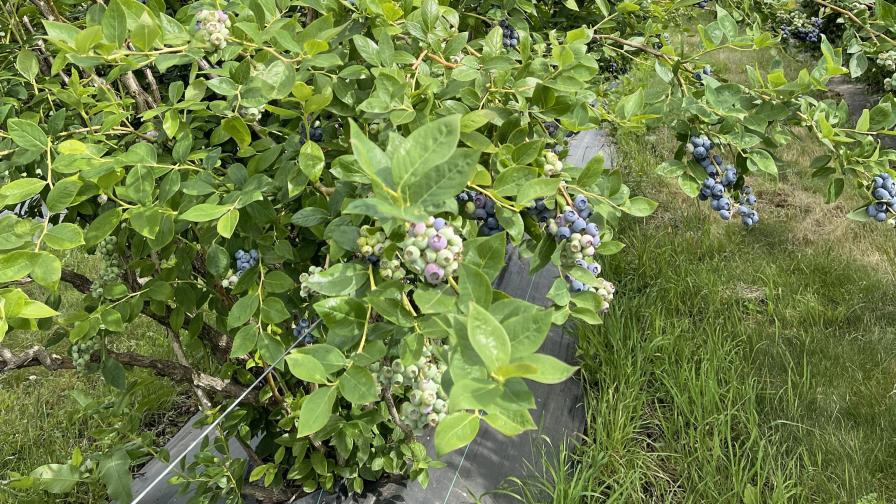How to fertilize blueberry crops correctly

The content of this article 'How to fertilize blueberry crops correctly' was prepared by Thomas Skernivitz for Growing Produce and has been revised and republished by FreshFruitPortal.com.
The ideal soil pH for blueberry — between 4.5 and 5.5 when measured in water — unfortunately bears little resemblance to the common soil pH for blueberry, according to Oregon State University Professor of Horticulture Bernadine Strik. “Soil pH outside of that range is pretty darn common,” she laments.
Hence the potential for problems arises. Nutrients are either in excess, or deficient, or not in a form that blueberry plants can use when soil pH is too low or too high, Strik says.
“(Growers) have to properly identify what nutrient problems are caused by,” Strik says. “If they’re pH-related, they’ll want to correct the pH before focusing on the nutrient.”
For example, when the pH is correct, and growers are fertilizing with ammonium sources of nitrogen — such as organic products like compost, which contains ammoniacal nitrogen, organically approved fertilizers, such as fish solubles and soy protein-based liquids, and conventional fertilizers, such as urea and ammonium sulfate — ammonium-nitrogen is released.
“And ammonium-nitrogen is what the blueberry plant prefers. They are happy,” Strik says.
“They take up the ammonium-nitrogen that they need, and relatively little of the ammonium is nitrified through soil nitrification to nitrate, which leaches. The process of nitrification is much slower at a low pH than it is at high pH.”
In contrast, if the same fertilizers are applied when the soil pH is above the ideal range for blueberry, nitrification occurs very rapidly, leaving little ammonium fertilizer available to the plant.
“Despite the money you’ve spent on product and labor to put out nitrogen, the plants will be deficient and not grow well,” Strik says. “Does this happen? Absolutely.”

Proper nutrient sources
Fertilizer sources and application methods available to growers include:
- Granular conventional and organic fertilizers (soil applied)
- Liquid conventional and organic fertilizers (soil applied, fertigated, or foliar)
- Controlled-release fertilizers (conventional), which are not currently recommended for blueberries, according to Strik.
- Composts
- Humic acids and seaweed products (liquid, fertigated, foliar; organic and conventional)
Fertilizer sources, such as fish solubles and feather meal, can differ even when both products contain ammonium, Strik says, citing her 2008-2016 trial.
Cumulative yield was 10% greater with feather meal than with fish solubles, but there was a cultivar effect between ‘Liberty’ and ‘Duke’.
While fertilizer source had no effect on ‘Liberty’, with ‘Duke’ there was 35% lower yield overall with fish solubles than with feather meal.
Organic fertilizer sources often contain nutrients beyond just nitrogen, Strik explains. Fish contains high potassium and phosphorus. Feather has more calcium, which is often an advantage, she adds, “and we found it to be so.”
When fish was used instead of feather, 45 pounds of potassium per acre were applied each year with the nitrogen even though the soil was sufficient in potassium and the plants were not deficient.
"This excess potassium had a negative effect on yield of ‘Duke’, which illustrates that too much of a nutrient can create problems,” Strik says.
“Choose products that have the proper nutrient source but also consider the cost per unit of nitrogen,” she says. “If you’re an organ-ic grower, calculate how much you are paying per pound of nitro-gen."
"It might look cheap, but then when you figure out how much you need to put on, you’ll notice big differences between products.”
Soil/Leaf testing
Strik recommends testing soil prior to planting as well as any amendments you may be incorporating into the soil.
Adjust the pH to the ideal range and modify any nutrients to get them to recommended levels.
Continue to monitor soil pH and nutrient levels after planting. Leaf tissue should be tested annually — at the proper time — to assess plant nutrient status and compare it to recommended leaf sufficiency levels.
“You want to sample the most recent fully expanded leaves,” Strik says. “Don’t pick the youngest leaf at the tip, and don’t pick old leaves at the base of shoots. Pick them from lateral shoots rather than vigorous whips. And sample all cultivars at the same time, regardless of fruiting season.”
Concentrations of some nutrients, such as nitrogen, phosphorus, and potassium, are naturally higher in the spring, while other nutrients, including magnesium, calcium, and sulfur, are higher later in the season.
“We want to pick a time of the year to sample when the nutrient concentrations are most stable,” Strik says. “Our recommended sampling time in Oregon is from late July to mid-August.”
Proper rates/timing
The target rate of a nutrient, particularly nitrogen, is based on plant age (canopy size) and research on plant uptake and nutrient needs, Strik says.
Timing is based on research related to plant uptake or use during the growing season and should be adjusted, she adds, based on the method of fertilizer application and speed of nutrient availability.
“Don’t apply fertilizers based on a formula-type management, like, ‘OK, I’m doing this because this grower does this’ or ‘I’m doing this because I’ve always done this,’” Strik says. “Base it on what the plant growth looks like and tissue and soil analysis results.”















































